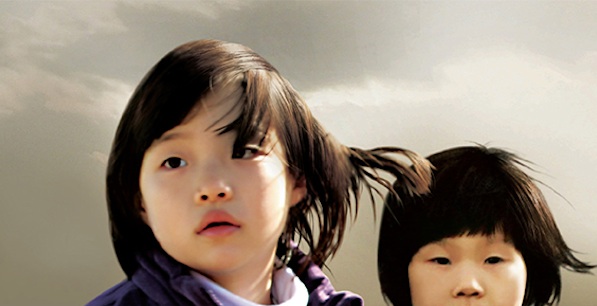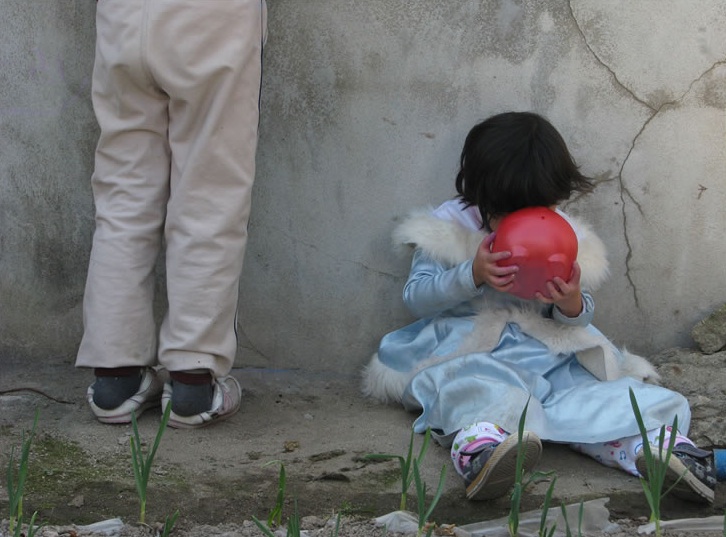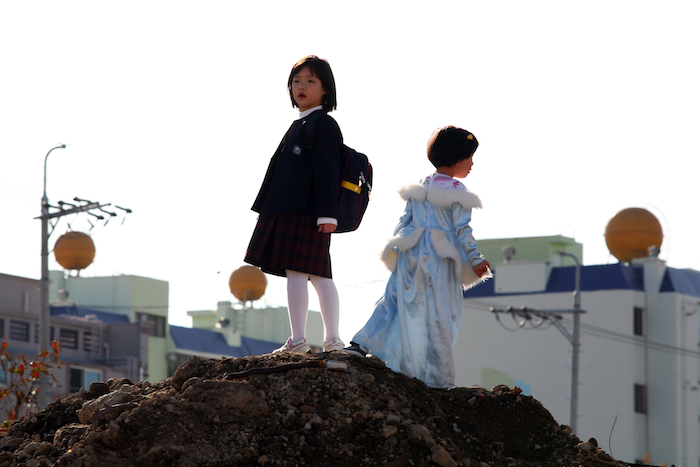Treeless Mountain sees childhood through an unsettled gaze. The 2008 South Korean film unfolds from the perspectives of two young sisters, six year-old Jin (played by Hee Yeon Kim) and four year-old Bin (Song Hee Kim), exploring their surroundings together as they move from the big city of Seoul towards first a small town, then eventually on to their grandparents’ rural home. They do so largely unaccompanied by adult companions: Their mother (Sooh Ah Lee) exits early on in the film in pursuit of her missing husband and the family’s absent patriarch, leaving the girls in the care of their oft-irritable Big Aunt (Mi Hyang Kim), who discards their attention in order to eat, drink and sleep alone.
Jin and Bin build a shared world in contrast to their elders’ solitude, however. Treeless Mountain (which won prizes at Berlin and Pusan in addition to screening at several other international festivals) invites viewers to share it with them. From its early, closely observed view of Jin bouncing off of other children between the end of the day’s school hours and her return home onwards, the film establishes that endings will give rise to new beginnings, and that whatever might initially seem to be loss can also lead to discovery and invention.
We see things largely through Jin’s eyes as she learns how to act as a surrogate mother for her sister, and as both girls create friends and adventures while awaiting their mother’s return. As time passes they fill a piggybank that their mother has given them with coins, treating the plastic pig as its own source of life whose fulfillment will coincide with their loved one’s arrival. They also wash clothes, gather sticks for kindling, and learn how to cook grasshoppers on a makeshift grill with other children outdoors. Throughout, their story is told in close third-person style, with roving handheld shots starting close to the girls, then darting outwards to swallow up the fields and markets before coming back to the little ones, resting for just a second or two before playfully breaking away once more.
This storytelling approach (skillfully realized by cinematographer Anne Misawa) differs from that of writer-director So Yong Kim’s previous film and debut feature, 2006 title In Between Days (made in close collaboration, as was Treeless Mountain, with her husband and career-long filmmaking partner Bradley Rust Gray, whose The Exploding Girl [2009] may also be viewed on this site). In In Between Days, the gaze of teenage Aimie (Jiseon Kim)—a South Korean immigrant finding her way along with a single mother and male friend in Toronto—will often fix on a person or an object for seconds before a camera jerk or cut leads the viewer violently away. In this case, as well, the style is motivated by the main character’s experiences. For a variety of stated and hidden reasons, Aimie’s ability to trust people has been broken, and each successive relationship she builds with a piece of her surrounding world forms part of her effort to rebuild it. The calmest, most stable images in the film are depopulated views of clouds over which Aimie’s voiceover asks her long-absent father how his life is going, expressing intimacy with the strength of a girl willing an imaginary friend into life.
All three of Kim’s feature films to date—In Between Days and Treeless Mountain, as well as 2012’s For Ellen—wed style to place and character psychology. (Kim is currently at work on a fiction feature called 70 about the relationships between a mother and her three children.) In Between Days’s urban freeze of Toronto matches Aimie’s wintry-but-thawing worldview; Treeless Mountain’s movement from city to village to farm is accompanied by perennially fragile sunlight reflecting childhood’s cheer; For Ellen, which follows a mentally unstable person named Joby (played by Paul Dano) across the American East Coast as he seeks reunion with his young daughter, begins scenes with classically framed views of people before collapsing into a close handheld style as Joby tries to hold himself together.
Each film reflects its filmmaker’s compassionate vision, aligned in close sympathy with that of her central characters. Together, they present an artistic rendering of her life experiences. Kim was born in the South Korean city of Pusan. When she was very young her mother divorced her father (who she did not see in person again after the age of five), then subsequently immigrated to the United States, leaving her for a time on her grandparents’ rice farm. She joined her mother in Los Angeles when she was 12 years old, and would eventually make Treeless Mountain, she has said, as a letter to her.
Kim wrote Treeless Mountain’s screenplay in 2005, before In Between Days’s completion; by the time of Treeless Mountain’s shoot, she had given birth to a baby girl herself. She chose to make the film in her own hometown of Hunghae, where she had grown up with her grandparents, and which she found to be essentially the same as when she was young. She liked the qualities of the place that she felt could help lead to “an honest film about the resilience of children,” as she expressed in a recent e-mail about the film. “I wanted the vastness in the fields and the old farmer’s home to feel isolating and terrifying for the viewer more than for the children, because actually the children are more open to these things than the adults are.”
She created the film’s impressionistic approach in close collaboration with her young actresses, often guiding from directly behind the camera while it was running. The essential result—a story made from a string of brilliant individually realized moments, out of which a viewer’s mind builds a tale—reflects Kim’s artistic formation as well as her family upbringing. She trained as a visual and performance artist and experimental filmmaker at the School of the Art Institute of Chicago, only gradually shifting to narrative work alongside Bradley Rust Gray. She has carried into her narrative films a number of qualities more typically associated with experimental cinema, among them a highlighting of the camera-eye’s subjectivity; a reliance on the viewer to subliminally connect events; a heightened attention to light, color, and sound; and an intensity focused upon the privileged instant, as though each individual fragment of waking life deserved to savored for its own sake.
These qualities appear with abundantly clarity in artworks like Kim’s four video letters to the Mexican filmmaker Fernando Eimbcke made between 2010 and 2011, which record simple sights like a setting sun and wrinkled hands with elegant rapture. But they are also present in the delectable moments of Treeless Mountain unfolding from Jin and Bin’s points of view. The girls’ fears of the future quickly dissipate in favor of savoring roasted grasshoppers; awareness of pain and of absence rise momentarily, only to be swept away with a smooth rush of wind. Kim’s film gives a fresh depiction of childhood by living in the present—an uncertain, perhaps unstable, vibrating time.
More information about the work of So Yong Kim and Bradley Rust Gray may be found at their website, http://www.soandbrad.com.
Aaron Cutler works as a programming aide for the São Paulo International Film Festival and keeps a film criticism site, The Moviegoer (http://aaroncutler.tumblr.com).







